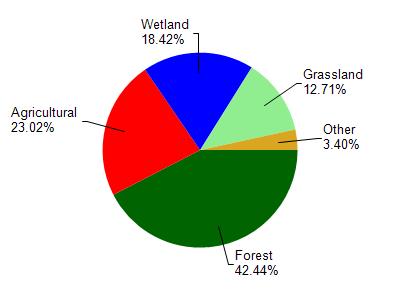Waupaca
No
Yes
No
Fish and Aquatic Life
Overview
Graham Lake (Nelson), in the South Branch Little Wolf River Watershed, is a 54.32 acre lake that falls in Waupaca County. This lake is an outstanding/exceptional resource water under NR102 under the Fisheries Program. This lake is managed for fishing and swimming and is currently not considered impaired.
Date 2011
Author Aquatic Biologist
Historical Description
Source: 1971, Surface Water Resources of Waupaca County Graham Lake, T24N, R11E, Section 10, Surface Acres = 54.5, S.D.F. = 1.23, Maximum Depth = 32 feet.
Springs and seepage supply water to this clear, hard water drained lake. A small outlet flows a short distance before entering an unnamed tributary of Leer Creek. Muck and sand are the predominant littoral bottom materials. The fishery is composed of northern pike, perch, largemouth bass, bluegill, black crappie, green sunfish, brown bullhead, and white sucker. Bluewing teal nest in the vicinity of the lake. Puddle ducks rest here during spring and fall migrations. The lake supports a significant number of muskrats. Hunting is allowed. Development is limited to one farm near the lake. Ownership of the existing access is presently being questioned; it may be private not public.
Date 1971
Author Surface Water Inventory Of Wisconsin
Condition
Wisconsin has over 84,000 miles of streams, 15,000 lakes and milllions of acres of wetlands. Assessing the condition of this vast amount of water is challenging. The state's water monitoring program uses a media-based, cross-program approach to analyze water condition. An updated monitoring strategy (2015-2020) is now available. Compliance with Clean Water Act fishable, swimmable standards are located in the Executive Summary of Water Condition in 2018. See also the 'monitoring and projects' tab.
Reports
Management Goals
Wisconsin's Water Quality Standards provide qualitative and quantitative goals for waters that are protective of Fishable, Swimmable conditions [Learn more]. Waters that do not meet water quality standards are considered impaired and restoration actions are planned and carried out until the water is once again fishable and swimmable
Management goals can include creation or implementation of a Total Maximum Daily Load analysis, a Nine Key Element Plan, or other restoration work, education and outreach and more. If specific recommendations exist for this water, they will be displayed below online.
Monitoring
Monitoring the condition of a river, stream, or lake includes gathering physical, chemical, biological, and habitat data. Comprehensive studies often gather all these parameters in great detail, while lighter assessment events will involve sampling physical, chemical and biological data such as macroinvertebrates. Aquatic macroinvertebrates and fish communities integrate watershed or catchment condition, providing great insight into overall ecosystem health. Chemical and habitat parameters tell researchers more about human induced problems including contaminated runoff, point source dischargers, or habitat issues that foster or limit the potential of aquatic communities to thrive in a given area. Wisconsin's Water Monitoring Strategy was recenty updated.
Grants and Management Projects
Monitoring Projects
| WBIC | Official Waterbody Name | Station ID | Station Name | Earliest Fieldwork Date | Latest Fieldwork Date | View Station | View Data |
|---|
| 279300 | Graham Lake | 10018131 | Graham Lake -- Access | | | Map | Data |
| 279300 | Graham Lake | 10007353 | Graham Lake | 7/27/1999 | 9/30/2017 | Map | Data |
|

Watershed Characteristics
Graham Lake is located in the South Branch Little Wolf River watershed which is 160.29 mi². Land use in the watershed is primarily forest (42.40%), agricultural (23%) and a mix of wetland (18.40%) and other uses (16.10%). This watershed has 166.00 stream miles, 2,070.64 lake acres and 19,091.22 wetland acres.
Nonpoint Source Characteristics
This watershed is ranked Low for runoff impacts on streams, High for runoff impacts on lakes and High for runoff impacts on groundwater and therefore has an overall rank of High. This value can be used in ranking the watershed or individual waterbodies for grant funding under state and county programs.However, all waters are affected by diffuse pollutant sources regardless of initial water quality. Applications for specific runoff projects under state or county grant programs may be pursued. For more information, go to surface water program grants.